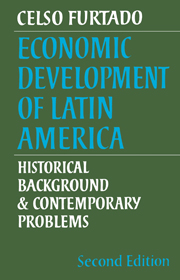Book contents
- Frontmatter
- Contents
- Tables
- Preface to the second edition
- Preface to the first edition
- Abbreviations
- Maps
- PART ONE FROM THE CONQUEST TO THE FORMATION OF NATION-STATES
- PART TWO ENTRY INTO THE SYSTEM OF INTERNATIONAL DIVISION OF LABOUR
- PART THREE THE TRADITIONAL STRUCTURAL PATTERN
- PART FOUR CHARACTERISTICS OF THE INDUSTRIALISATION PROCESS
- PART FIVE REORIENTATION OF DEVELOPMENT IN THE RECENT PERIOD
- 13 Evolution of macroeconomic structures
- 14 Agricultural sector
- 15 Industrial sector
- 16 Inadequate growth and the reorientation of development
- PART SIX INTERNATIONAL RELATIONS
- PART SEVEN INTRA-REGIONAL RELATIONS
- PART EIGHT STRUCTURAL RECONSTRUCTION POLICIES
- Bibliography
- Index
14 - Agricultural sector
Published online by Cambridge University Press: 25 January 2010
- Frontmatter
- Contents
- Tables
- Preface to the second edition
- Preface to the first edition
- Abbreviations
- Maps
- PART ONE FROM THE CONQUEST TO THE FORMATION OF NATION-STATES
- PART TWO ENTRY INTO THE SYSTEM OF INTERNATIONAL DIVISION OF LABOUR
- PART THREE THE TRADITIONAL STRUCTURAL PATTERN
- PART FOUR CHARACTERISTICS OF THE INDUSTRIALISATION PROCESS
- PART FIVE REORIENTATION OF DEVELOPMENT IN THE RECENT PERIOD
- 13 Evolution of macroeconomic structures
- 14 Agricultural sector
- 15 Industrial sector
- 16 Inadequate growth and the reorientation of development
- PART SIX INTERNATIONAL RELATIONS
- PART SEVEN INTRA-REGIONAL RELATIONS
- PART EIGHT STRUCTURAL RECONSTRUCTION POLICIES
- Bibliography
- Index
Summary
Agricultural production
The structural features of Latin American agriculture, described in detail in chapter 7, largely account for the behaviour of this sector in recent years. By and large we find a pattern of extensive farming, that is, agriculture geared to a utilisation of land and labour involving limited capital outlays. Moreover, the emphasis is on production of a few commodities, mainly those destined for export, enjoying a privileged position and monopolising available credit facilities and infrastructure. It is with this background in mind that we must analyse the evolution of the agricultural sector over the past few decades, a period characterised by the weakening of external demand and the expansion of the domestic market. The population explosion, rapid urbanisation and the rise in purchasing power of part of the population failed to elicit the required response from the Latin American agricultural sector, since prevailing systems of extensive agriculture were no longer adequate methods for coping with the situation.
The figures given in Table 14.1 show that agriculture and livestock production did not always keep pace with population growth. It should be added that these figures underestimate the insufficiency of supply since as a result of rapid urbanisation, demand for agricultural surpluses has grown much more rapidly than the population. Even if we assume that the food consumption patterns of the population that has emigrated from the countryside to the towns have remained the same, we would still have to consider the much higher wastage coefficient involved in transporting food.
- Type
- Chapter
- Information
- Economic Development of Latin AmericaHistorical Background and Contemporary Problems, pp. 141 - 151Publisher: Cambridge University PressPrint publication year: 1977



